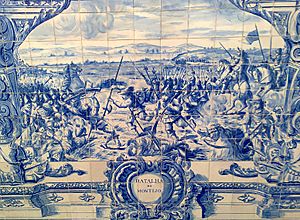Battle of Montijo facts for kids
Quick facts for kids Battle of Montijo |
|||||||
|---|---|---|---|---|---|---|---|
| Part of the Portuguese Restoration War | |||||||
 The Battle of Montijo (Military Museum of Lisbon) |
|||||||
|
|||||||
| Belligerents | |||||||
| Commanders and leaders | |||||||
| Matias de Albuquerque | Baron of Mollingen Marquis of Torrecusa |
||||||
| Strength | |||||||
| 6,000 infantry and 1,100 cavalry (6 guns) | 4,000 infantry and 1,700 cavalry (2 guns) | ||||||
| Casualties and losses | |||||||
| 3,000 dead and wounded (disputed) or about 900 dead and captured |
3,000 dead and wounded (disputed) or 433 dead 380 wounded |
||||||
The Battle of Montijo was fought on 26 May 1644, in Montijo, Spain, between Portuguese and Spanish forces. Although the battle ended with a Portuguese victory, the Spanish saw it as a strategic success as they claimed to have prevented Matias de Albuquerque from capturing Badajoz, despite Albuquerque having no intention of attacking the city. Due to the chaotic nature of the battle, casualty figures vary.
Contents
Background
Portuguese General Matias de Albuquerque knew the Spanish were commanded by the Marquis of Torrecusa, a renowned military tactician, and wanted to affirm his own presence. He managed to gather 6,000 infantry, 1,100 cavalry and 6 cannons, in order to give battle. He crossed the frontier attacking, pillaging and burning Vilar del Rey, Puebla and Boca de Manfarete until reaching the town of Montijo, which surrendered without a fight.
Battle
Not having encountered the Spanish army, Matias de Albuquerque decided to return to Alentejo. While on march, the Portuguese were confronted by a Spanish force from Torrecusa's army led by the Baron of Mollingen consisting of 4,000 infantry and 1,700 cavalry. On 26 May 1644 the two armies met not far from Montijo.
The forces of Mollingen adopted a semi circle formation, which would permit a simultaneous attack on the Portuguese front and flanks. Matias de Albuquerque, marching in a slow pace towards Portugal, had prepared for a rear attack by placing the infantry in two defensive lines with the strongest formations in the rear, the baggage wagons in the vanguard and the cavalry split between the two flanks.
The six cannons of the Portuguese initiated the hostilities, the Spanish side soon replied, but very ineffectively. The Spanish cavalry attacked the Portuguese left flank, routing the 150 Dutch cavalry commanded by Captain Piper. The panic spread to the rest of the cavalry on both flanks who abandoned the field through their own lines, taking refuge in woods near Xévora, leaving the infantry disorganized. Led by Mollingen himself, the Spanish cavalry easily opened a breach in the centre of the Portuguese positions, taking the Portuguese artillery. Thinking that the Battle was won, Mollingen troops scattered themselves without care on the field looting. Albuquerque's horse was killed and he was found fighting on foot by a French officer named Lamorlé (fighting for the Portuguese) who gave him his own horse.
Taking advantage of the Spanish lack of reserves and dispersion, Matias de Albuquerque and his officers rallied some of the scattered troops and quickly retook the Portuguese artillery. D. João da Costa, a Portuguese artillery officer, efficiently used the artillery to stop the Spanish forces from regrouping. The rallied Portuguese troops took back the field, and drove the Spaniards across the Guadiana inflicting heavy losses.
Aftermath
On the following day the Portuguese troops returned to Campo Maior. Both sides claimed victory, as well as having caused high casualties to each other. When news of the victory achieved by Albuquerque reached King John IV of Portugal he awarded the general with the title of Count of Alegrete. Madrid, as well as Lisbon rejoiced with news of the battle that had great repercussion in the European courts.
In culture
The Spanish playwrights Pedro Francisco Lamini and Sr. Durán composed respectively the comedy El más valiente Extremeño, Bernardo del Montijo, el segundo Don Rodrigo Díaz de Vivar and the poem in his collection Romances vulgares de valentías, guapezas y desafueros in honor to the Battle. The Portuguese João Soares da Gama also did it in his Batalha do Montijo.
See also
 In Spanish: Batalla de Montijo para niños
In Spanish: Batalla de Montijo para niños

